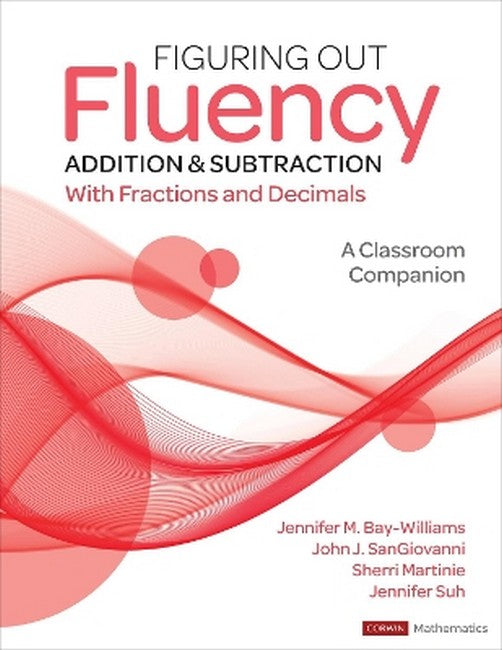PART 1: FIGURING OUT FLUENCY: KEY IDEAS PART 2: STRATEGY MODULES Module 1 Foundations for Reasoning Strategies Module 2 Count On/Count Back Strategy Module 3 Make a Whole Strategy Module 4 Think Addition Strategy Module 5 Compensation Strategy Module 6 Partial Sums and Differences Strategy Module 7 Standard Algorithms PART 3: PUTTING IT ALL TOGETHER: DEVELOPING FLUENCY
Request Academic Copy
Please copy the ISBN for submitting review copy form
Description
"Figuring Out Fluency-Addition and Subtraction With Fractions and Decimals is a must-read book to ensure students develop computational fluency through brilliant targeted strategies to help students work with fractions and decimals flexibly. The authors provide clear examples, strategies grounded in research and best practice, and student-centered engaging games to help each and every student develop computational fluency while developing their math identity and agency! The clever games can be used both in class with students and shared with families! As a former middle school mathematics teacher and K-5 coach, I can see that this book is a must-have for all mathematics teachers, interventionists, support staff, and coaches." -- Georgina Rivera "It can be extremely difficult not to fall back on rules and procedures when trying to navigate fluency with fractions and decimals. Thankfully, Figuring Out Fluency offers a conceptual roadmap that every teacher can turn to as they look to build meaningful fluency in their classroom." -- Graham Fletcher "These strategies, routines, games, and centers are the perfect companion pieces to the math instruction I provide in my classroom daily. I appreciate the strategy briefs for families so they can support their child at home. Every teacher needs this book!" -- Andrea Fields "This is the resource that the educational world has been wishing and waiting for! This carefully crafted guide tackles mathematical concepts that traditionally leave students confused and teachers frustrated! It will inspire and support educators in their journey to integrate rigorous, high-quality fluency practice." -- Allyson Lyman "This book is a must for all Grade 3-8 teachers who teach fraction and decimal operations. It is chock full of strategies, automaticities, assessments, and activities that are easy to understand and empowering to teach. Students' confidence will soar when they learn how to use these efficient, flexible, and accurate strategies." -- Theresa Wills "This Figuring Out Fluency companion is one of those rare finds that provides activities to implement immediately with students while also embedding professional learning for teachers and coaches. I appreciate the intentional design, specific strategies, and observational tools that focus on sense making and application-two critical components of transfer. The examples of how to assess fluency help educators visualize practices that provide valuable information about student strengths while ensuring students maintain a positive mathematical identity." -- Catherine Castillo "The explicit strategy instruction provided in this book allows access for ALL students in a practical, hands-on approach. So many worked examples, routines, and games to teach and support student reasoning with fraction and decimal operations. This is a go-to for all math educators, coaches, specialists, and interventionists!" -- Nichole DeMotte "This book is such an eye-opener for providing interventions and strategies for students and supporting teachers that I coach. Fluency isn't about timed tests or "drill and kill" but providing students with rich discourse, games, tasks, routines, and more. I'm so excited to delve into this much-needed resource more." -- Tomika R. Altman "A needed addition to mathematics education! This book establishes a broader definition of fluency and emphasizes the importance of helping students develop and use relationships and strategies to solve problems. Bay-Williams, SanGiovanni, Martinie, and Suh outline which major relationships and strategies students need to develop stronger mathematical reasoning!" -- Pam Harris "Oftentimes, fractions and decimals evoke fear in students and also may test a teacher's confidence with how to teach addition and subtraction of fractions and decimals beyond a rote procedure. This book is a must-have resource filled with activities and resources to foster mathematicians' flexibility, accuracy, and efficiency. It provides ideas that will help mathematicians have a true understanding and become what it really means to be proficient." -- Dawn Jacobs "Where was this book when I taught students in 4th and 5th grade? From the Preface to the References, Figuring Out Fluency-Addition and Subtraction With Fractions and Decimals: A Classroom Companion summarizes the key ideas about fluency, teaches the reader about the "must know" strategies, and gives specific games, routines, and centers to develop students' fluency. This book is a must-have for anyone who teaches addition and subtraction of decimals and fractions!" -- Laura Vizdos Tomas "This book places mathematical thinking front and center! The authors make the compelling case using myriad examples that fluency requires reasoning and relies on conceptual understanding. They provide a treasure trove of engaging activities teachers can use to help their students develop fluency with adding and subtracting fractions and decimals. If you want your students to confidently choose and flexibly use a range of strategies when working with fractions and decimals, you must read this book!" -- Grace Kelemanik "Some students can do magic! At least that's what it seems like to their classmates who don't have the "secret" strategies for calculating with fractions and decimals. Isn't this true for adults as well? But it isn't magic. There is no secret! All of the games and activities primary students learn to make sense of whole number computation are in this book, refashioned to develop the same number sense and skills with fractions and decimal fractions. Can your students play Make 100? Yes? Then they can also play Make a Whole. Read this book, reveal the "secret" strategies for your students, and soon you and your students will be the ones asked to make magic." -- Kimberly Morrow-Leong

